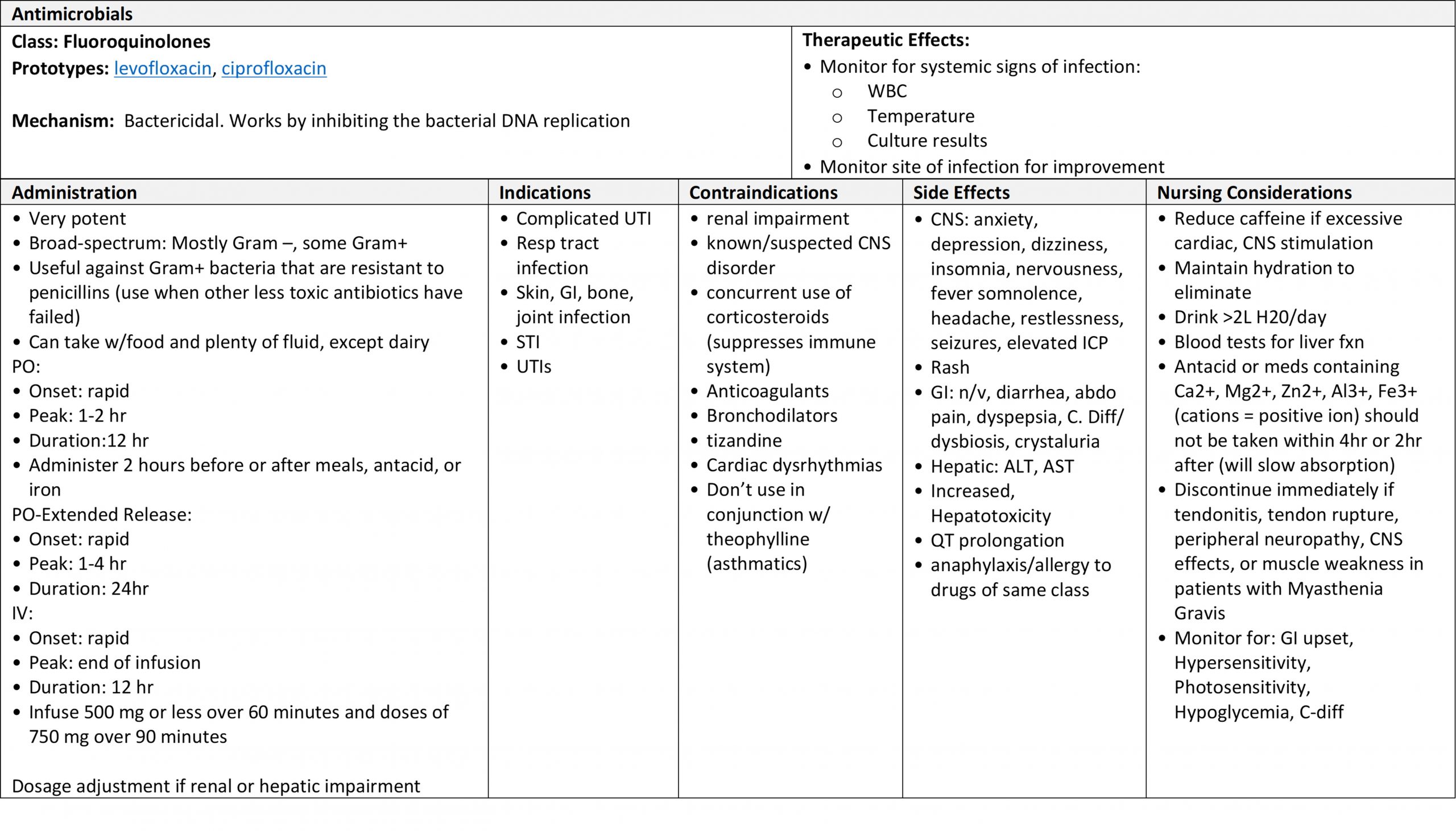Antimicrobials
3.11 Fluoroquinolones
Open Resources for Nursing (Open RN)
Indications for Use: Fluoroquinolones may be used to treat pneumonia or complicated skin or urinary tract infections.
Mechanism of Action: Fluoroquinolones are a synthetic antibacterial medication that work by inhibiting the bacterial DNA replication. They are bacteriocidal due to the action they take against the DNA of the bacterial cell wall. Many fluoroquinolones are broad spectrum and effective against a wide variety of both gram-positive and gram-negative bacteria.
Nursing Considerations Across the Lifespan: Fluoroquinolones are safe to use in pediatrics and with older adults. Dose adjustments are required for renal insufficiency. There is limited data on safety in pregnancy.
Specific Administration Considerations: Clients taking oral fluoroquinolones should avoid the use of antacid medication as antacids significantly impede absorption. Clients should also be instructed to take oral fluoroquinolones with a full glass of water two hours before or after meals to enhance absorption and prevent crystalluria. Fluoroquinolone therapy is contraindicated in children except for complicated UTIs, pyelonephritis, plague, or post Anthrax exposure and should be used cautiously in pregnancy.[1]
Black Box Warning: Black Box Warnings are the strongest warnings issued by the Federal Drug Association (FDA) (equivalent to “Safety Warnings” by Health Canada) and signify that the medical studies have indicated that the drug carries a significant risk of serious or life-threatening adverse effects.
Fluoroquinolones, including, have been associated with disabling and potentially irreversible serious adverse reactions, including:
- Tendinitis and tendon rupture
- Peripheral neuropathy
- Central nervous system effects
- Exacerbation of muscle weakness in clients with myasthenia gravis
In clients who experience any of these serious adverse reactions, discontinue the medication immediately, and avoid the use of fluoroquinolones.
Client Teaching & Education: All clients on fluoroquinolone therapy should be instructed to avoid direct and indirect sunlight due to the photosensitivity that can be experienced while on these medications. The client should take measures to ensure that dosages are spaced evenly throughout the day and that fluid balance is maintained. It is important to maintain an intake of 1500mL-2000mL per day while taking the medication. The client should be advised that medications containing calcium, aluminum, iron, or zinc may impair absorption and should be avoided. Other side effects of fluoroquinolones increase drowsiness. Additionally, the client should be cautioned to monitor for episodes of fainting or decreased heart rate and report any history of prolonged QT syndrome. If a client notices peripheral neuropathy occurring, this should be reported to the healthcare provider. Additional side effects to monitor include increased tendon pain, jaundice, rash, or mood changes.[2]
Now let’s take a closer look at the medication card for levofloxacin in Table 3.10.[3][4]
Table 3.10 Fluoroquinolone Medication Card
Class: Flouroquinolones (protypes: levofloxacin, ciprofloxacin)

Clinical Reasoning and Decision-Making Activity 3.10a
Utilizing the above information, consider the following clinical scenario question:
A nurse is administering levofloxacin to a client diagnosed with pneumonia. The client reports that he has pain “above his heel” today. The nurse assesses and discovers the pain is over the Achilles tendon. What is the nurse’s next best response?
Note: Answers to the Critical Thinking activities can be found in the “Answer Key” sections at the end of the book.
Media Attributions
- Fluoroquinolones
- This work is a derivative of Microbiology by OpenStax licensed under CC BY 4.0. Access for free at https://openstax.org/books/microbiology/pages/1-introduction ↵
- uCentral from Unbound Medicine. https://www.unboundmedicine.com/ucentral ↵
- Daily Med, https://dailymed.nlm.nih.gov/dailymed/index.cfm, used for hyperlinked medications in this module. Retrieved June 27, 2019 ↵
- UpToDate (2021). Levofloxacin. https://www.uptodate.com/contents/search ↵
The strongest warnings issued by the Federal Drug Association (FDA) that signify a drug carries a significant risk of serious or life-threatening adverse effects.

